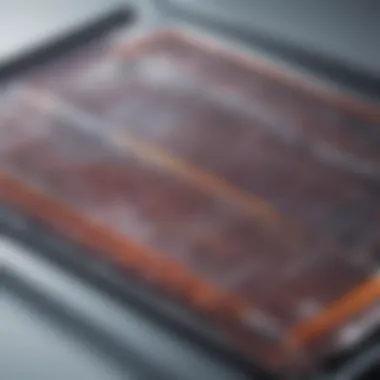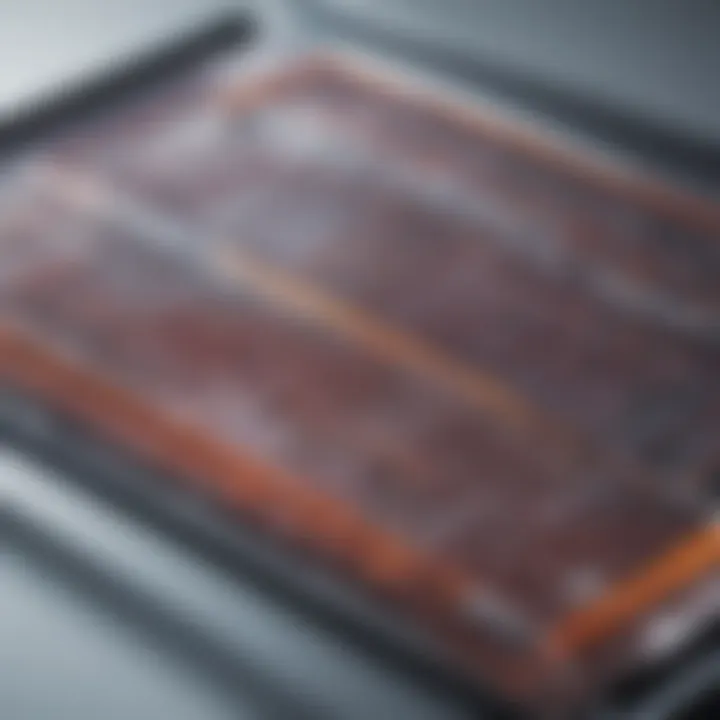Acrylamide Gel Electrophoresis: Techniques and Innovations


Intro
Acrylamide gel electrophoresis is a fundamental procedure in the fields of molecular biology and biochemistry. It facilitates the separation of proteins and nucleic acids based on their size and charge. This technique has gained significant traction in research laboratories and clinical settings alike, signifying its importance in various applications such as genetic analysis, protein purification, and biomolecular characterization.
As scientific research progresses, the relevance of acrylamide gel electrophoresis remains steadfast. New methodologies and innovations continually enhance its utility and efficiency, making it critical for both fundamental and applied science. The following sections will explore the depths of this technique, analyzing its foundational principles, methodologies, and the potential future directions it may take.
Foreword to Acrylamide Gel Electrophoresis
Acrylamide gel electrophoresis is a fundamental technique widely used in molecular biology and biochemistry. It plays a critical role in separating proteins and nucleic acids based on their size and charge. This section emphasizes the importance of acrylamide gel electrophoresis, considering various elements such as its methodology and applications across different scientific realms.
Definition and Background
Acrylamide gel electrophoresis involves the use of a gel matrix created from the polymerization of acrylamide and bisacrylamide. The structure of this gel defines the pathways through which biomolecules migrate when an electric field is applied. The process hinges on the principle that molecules will move through the gel at rates inversely proportional to their size. Smaller molecules maneuver through the gel with ease, while larger ones encounter resistance, thus separating different species effectively.
This technique was first developed in the 1950s. Since then, it has evolved into a standard method employed in laboratories globally. The gels can vary in concentration, determining which size range of molecules can be analyzed. The technique also allows for varying conditions, leading to different results based on buffer systems, voltage, and gel composition.
Importance in Biotechnology
The significance of acrylamide gel electrophoresis in the field of biotechnology cannot be overstated. Here are a few benefits that illustrate its utility:
- Separation Efficiency: Acrylamide gel provides high resolution for separating biomolecules, which is crucial for accurate analysis.
- Versatility: It can be adapted for different applications, including protein purification, nucleic acid analysis, and more.
- Compatibility: The technique integrates well with various visualization methods, such as staining and fluorescent imaging, enhancing detection sensitivity.
- Research and Development: It is widely used in research settings for studying the characteristics of enzymes, antibodies, and genetic material.
Overall, acrylamide gel electrophoresis remains a cornerstone technique in molecular biology. Its ability to deliver precise and reproducible results has made it indispensable in both academic research and industrial applications.
Chemical Composition of Acrylamide Gels
Understanding the chemical composition of acrylamide gels is crucial for optimizing electrophoresis techniques. The balance between acrylamide and bisacrylamide impacts gel characteristics and performance. This section delves into the roles of these components and how their concentration affects separation processes.
Role of Acrylamide and Bisacrylamide
Acrylamide is the primary substance used in the creation of gel matrices. Its unique ability to polymerize under specific conditions allows the formation of a gel matrix that plays a key role in electrophoresis. Bisacrylamide acts as a cross-linker in this process. This means it helps to create a stable and structured network of acrylamide chains. The presence of bisacrylamide provides mechanical strength to the gel, enabling it to hold its shape during the electrophoresis process.
Choosing the right ratio of acrylamide to bisacrylamide is imperative. Ratios that are too high can yield gels that are too rigid, affecting the migration of proteins. Conversely, low ratios result in soft gels that might not effectively separate larger molecules. An optimal balance ensures a consistent sieving matrix suitable for various molecular sizes. The typical ratio used in many protocols is around 37.5:1 for acrylamide to bisacrylamide, but adjustments can be made based on specific experimental needs.
Concentration and Effects on Separation
The concentration of acrylamide in the gel influences separation effectiveness. Higher concentrations create denser gels, suitable for smaller proteins and nucleic acids. This density acts as a more restrictive sieve, inhibiting the movement of larger molecules. On the other hand, lower concentrations allow larger molecules to traverse through the matrix with ease.
To achieve optimal results, it is essential to select the appropriate concentration based on the size of the target molecules. Common practices involve using gels with concentrations between 5% to 15% acrylamide, depending on whether the target molecules are small peptides or larger proteins.
In practice, experimenting with different concentrations can help define the best conditions for specific applications. Here are some key points to consider:
- 5% to 7% gels are suitable for large proteins and nucleic acids.
- 8% to 12% gels are common for average-sized molecules.
- > 12% gels are often used for small peptides or nucleic acid fragments.
By adjusting the chemical composition deliberately, researchers can tailor the gels for heightened resolution and improved separation outcomes.
"The choice of acrylamide concentration is perhaps the most crucial parameter affecting separation in electrophoresis."
A careful analysis of these components will aid in achieving desired separation profiles in acrylamide gel electrophoresis.
Fundamentals of Gel Electrophoresis
Understanding the fundamentals of gel electrophoresis is vital for grasping the broader topic of acrylamide gel electrophoresis. This foundational knowledge not only elucidates the underlying principles but also showcases the technique’s breadth of applications across molecular biology and biochemistry.
Principles of Electrophoresis
Electrophoresis rests on the principle that charged particles will migrate in an electric field. The direction and rate of movement depend on several factors, including the size and charge of the particles.
- Charge: Proteins and nucleic acids carry intrinsic charges that influence their migration. The application of an electric field propels these molecules towards the electrode of opposite charge.
- Size: Size is a crucial factor. Smaller molecules generally move faster through the gel matrix compared to larger ones. This difference in mobility allows for effective separation during the electrophoresis process.
- Medium Influence: The gel medium, often composed of acrylamide, also plays a role. The percentage concentration of acrylamide impacts the pore size of the gel, influencing how molecules with varying sizes migrate.
The ability to control these parameters means researchers can optimize conditions for particular experiments, making electrophoresis a flexible tool for separating biological macromolecules.
Mechanisms of Migration
Migration mechanisms are central to achieving the desired separation in gel electrophoresis. Several phenomena contribute to the behavior of molecules during this process:
- Electroosmosis: This refers to the movement of fluid in the gel in response to an electric field, which may carry along solutes with it. This can influence the observed mobility of particles and complex the interpretation of results.
- Size Exclusion: As molecules traverse the gel, they encounter resistance based on their size. The gel acts like a sieve, where larger molecules face more hindrance than smaller ones, further aiding in separation.
- Biomolecular Interactions: Intermolecular interactions can also modify the migration rate. Proteins may interact with the gel matrix or with each other, causing variations in movement that can lead to unexpected outcomes.
The ability to fine-tune these aspects allows for precision in experiments, significantly enhancing results in research settings.
In summary, the fundamentals of gel electrophoresis establish a framework for understanding how acrylamide gel electrophoresis functions. Grasping these principles ensures that researchers are better prepared to interpret their results and apply the technique effectively across various applications.
Preparing Acrylamide Gels
Preparing acrylamide gels is fundamental to the process of gel electrophoresis. The quality and consistency of the gels significantly influence the separation of biomolecules. Whether for protein analysis or nucleic acid studies, the preparation of gels affects the clarity and resolution of results. It is crucial to understand the various steps involved and the considerations that come with each.
Preparation Techniques
The preparation of acrylamide gels involves precise measurements and established protocols. Generally, two main techniques are used: standard and gradient gel preparation. The standard technique consists of mixing acrylamide and bisacrylamide in a specified ratio, usually 30% acrylamide and 0.8% bisacrylamide. This mixture is then diluted in buffer to create the desired working concentration.
A gradient gel, on the other hand, allows for separation over a range of sizes and is particularly useful for analyzing proteins with varying molecular weights. In this case, two solutions with different concentrations of acrylamide are layered before polymerization, which creates a gradient throughout the gel.
Important equipment includes a gel casting system, pipettes for accurate measurement, and a magnetic stirrer to ensure even mixing. Safety measures during gel preparation are also essential, as acrylamide is a neurotoxin. Proper personal protective equipment should always be worn.
Casting Gels: Best Practices
Casting gels is a meticulous process that requires attention to detail to ensure successful outcomes. Adhering to best practices can enhance both the quality and reproducibility of the gels. Here are some key considerations:
- Cleanliness: Every component, including glass plates and spacers, should be clean to prevent contamination that could lead to artifacts.
- Degassing: If high-concentration gels are used, degassing the solution before casting removes any air bubbles that may form during polymerization, ensuring a uniform gel density.
- Temperature Control: Be mindful of the ambient temperature, as it can affect polymerization. Consistent temperatures help produce gels with uniform polymer mesh sizes.
- Casting Technique: Fill the gel casting apparatus slowly to minimize bubbles and ensure that the gel sets uniformly.


"Consistency in gel preparation lays the foundation for reproducible and reliable electrophoresis results."
Following these practices helps establish a reliable workflow, increasing confidence in the analytical outcomes from the gels. In summary, preparation of acrylamide gels is not just about mixing; it is about precision and control to obtain optimal results in electrophoresis.
Running Gel Electrophoresis
Running gel electrophoresis is an essential process in molecular biology and biochemistry. This procedure allows scientists to sort and analyze proteins and nucleic acids based on size and charge under an electric field. The significance of this section lies in the detailed examination of the equipment, buffer systems, and considerations that inform the effective running of gels. By understanding these aspects, researchers can improve their results and ensure the accuracy of their experiments.
Electrophoresis Equipment Overview
The equipment used in gel electrophoresis plays a critical role in the experiment’s success. Typically, the setup includes the following main components:
- Power Supply: Supplies voltage to drive the migration of molecules through the gel. Voltage settings often range from 50 to 250 volts, depending on the gel type and sample requirements.
- Gel Casting Apparatus: Used to prepare gels in different sizes and configurations. Options include standard gel plates and mini-gel setups.
- Gel Tank: The chamber where the gel is placed, filled with buffer solution for conduction. Tanks can accommodate various gel sizes.
- Sample Loading Devices: Tools like micro pipettes for loading samples into the gel wells accurately. Proper loading minimizes sample contamination and ensures even distribution.
Each piece of equipment must be well-maintained for optimal results. For instance, the gel tank should be checked for leaks, while the power supply's voltage settings should match the gel specifications determined during preparation.
Buffer Systems and Their Impact
Buffer systems in electrophoresis are crucial for maintaining pH and conductivity during the run. The selection of buffer can greatly affect the separation of macromolecules. Two common buffer types are:
- Tris-Glycine Buffer: This buffer is frequently used for SDS-PAGE. It maintains a stable pH and provides good resolution for proteins.
- TAE (Tris-Acetate-EDTA) Buffer: This system is often employed for nucleic acid separations. It helps minimize charge effects that can skew results.
It is important to match buffer choice to the type of macromolecule and analysis goals.
The buffer system impacts the running time and resolution of bands on the gel, with notable differences in migration rates observed for different pH levels and compositions. Therefore, understanding and optimizing buffer conditions is vital for clear and interpretable results in any electrophoresis experiment.
In summary, running gel electrophoresis hinges on a well-organized approach that encompasses appropriate equipment and buffer systems. Through understanding these components, researchers can enhance their methodologies, leading to improved outcomes in protein and nucleic acid analysis.
Visualization Techniques
The significance of visualization techniques in acrylamide gel electrophoresis cannot be overstated. These methods are essential for interpreting the results of electrophoresis, allowing for the clear and accurate identification of proteins and nucleic acids after separation. Effective visualization not only enhances the understanding of experimental outcomes but also provides critical insights into the properties of the samples analyzed.
Several factors influence the choice of visualization technique, including the type of biomolecules being examined, the goals of the research, and the sensitivity required for detection. Furthermore, these techniques can also impact the quantification of the samples, facilitating comparative studies between different experimental conditions or treatments. Their successful application boosts the reliability of electrophoresis as a fundamental technique in molecular biology.
Staining Methods for Proteins
Staining is a key technique for visualizing proteins post-electrophoresis. Commonly used staining methods include Coomassie Brilliant Blue and silver staining. Coomassie Brilliant Blue is favored for its balance between sensitivity and ease of use. It is suitable for routine analysis, providing a decent visual representation of protein bands at concentrations within the microgram range.
Silver staining, while more sensitive, is often reserved for cases requiring detection of low-abundance proteins. The silver ions interact with proteins, resulting in a more intense signal. This method may be more time-consuming and involves additional reagents, posing some challenges in reproducibility. Despite these challenges, silver staining remains a powerful option for identifying proteins in complex biological samples.
Nucleic Acid Visualization Strategies
In terms of nucleic acids, visualization strategies differ from those used for proteins. Ethidium bromide remains one of the most widely used dyes due to its ability to intercalate between the base pairs of DNA. When exposed to ultraviolet light, it emits fluorescence, marking the nucleic acid bands effectively.
Alternative nucleic acid stains, such as SYBR Green and GelRed, have emerged as safer options, reducing potential hazardous waste and offering higher sensitivity. These dyes are crucial for applications involving quantitative PCR and nucleic acid fragment analysis.
Overall, selecting the appropriate visualization method involves careful considerations of the specific needs of the experiment, such as sensitivity, specificity, and operational safety, ensuring that results are both accurate and justified.
Applications of Acrylamide Gel Electrophoresis
Acrylamide gel electrophoresis serves as a foundational technique in molecular biology, enabling the separation and analysis of proteins and nucleic acids. Its versatility and precision make it invaluable in various applications across scientific disciplines. Understanding these applications is crucial in appreciating how acrylamide gel electrophoresis has propelled advancements in research and diagnostics. These applications will enrich our understanding of specific elements, benefits, and considerations inherent in employing this technique.
Protein Analysis and Characterization
Acrylamide gel electrophoresis is a staple method for protein analysis, particularly in discovering protein size, structure, and charge. Sodium dodecyl sulfate polyacrylamide gel electrophoresis (SDS-PAGE) is a widely utilized method for separating proteins based on their molecular weight. The proteins are denatured and subjected to an electric field, causing them to migrate through the gel matrix. Based on their size, proteins separate into distinct bands, which can then be visualized and analyzed, providing insights into their characteristics.
There are several important benefits in using acrylamide gels for protein analysis. For instance, they provide high resolution, allowing for the detection of even small differences in molecular size. Also, the ability to stain and visualize proteins using various methods further enhances the applicability of this technique in protein characterization.
"Acrylamide gel electrophoresis remains a gold standard for studying proteins in biochemistry and molecular biology."
In terms of considerations, factors such as gel concentration and the choice of buffer can significantly influence migration patterns. As a result, careful optimization is essential to ensure reliable and reproducible results when using this method for protein analysis.
Nucleic Acid Fragmentation Studies
In addition to protein analysis, acrylamide gel electrophoresis is critical for studying nucleic acid fragments, including DNA and RNA. Researchers often utilize this technique to examine the integrity of nucleic acids and their fragmentation. The separation of nucleic acid fragments can yield significant information about DNA quality, size, and the presence of specific sequences.
For instance, acrylamide gels enable researchers to assess the effectiveness of restriction enzyme digestion or PCR amplification. By comparing the size of DNA fragments against a ladder or standard, one can determine if the expected sizes align with the hypothesized outcomes. In RNA studies, acrylamide gel electrophoresis can help evaluate the efficiency of reverse transcription or examine mRNA stability.
Overall, the application of acrylamide gel electrophoresis for nucleic acid fragmentation studies emphasizes its significance in gene expression analysis, molecular diagnostics, and genetic engineering. The technique's ability to provide clarity and precision in result interpretation makes it a valuable tool in modern biotechnology.
Limitations and Challenges
In the field of molecular biology, acrylamide gel electrophoresis is widely accepted. However, understanding its limitations and challenges is critical for effective application. These issues must be addressed to improve results and ensure reliability in research outcomes. Knowledge of potential limitation can help researchers make informed choices about experimental design and interpretation of results.
Potential Artifacts in Results
The interpretation of acrylamide gel electrophoresis results can sometimes be misleading due to artifacts. Artifacts may arise from various factors during gel preparation, electrophoresis, or visualization processes. Some common types of artifacts include:
- Sample degradation: Improper handling of samples can lead to changes in proteins or nucleic acids, causing unexpected band patterns.
- Electrical field issues: Variations in the voltage or current applied can lead to uneven migration of molecules, creating distortions in the bands.
- Overloading samples: Excessive sample load can cause band broadening or smearing, complicating the interpretation.
- Staining inconsistencies: Non-uniform staining may affect the visibility of bands, leading to inaccuracies in quantification.
These artifacts highlight the need for careful methodology and attention to detail. By understanding these potential issues, researchers can develop strategies to mitigate such artifacts and enhance the reliability of their results.
Troubleshooting Common Issues
Common issues encountered during acrylamide gel electrophoresis can hinder experimental success. It is important to have strategies for quickly diagnosing and resolving these concerns. Here is a summary of frequent challenges and their solutions:
- Poor Resolution:
- Smearing of Bands:
- Uneven Band Patterns:
- Causes: High sample load, incorrect gel concentration, or using the wrong buffer.
- Solutions: Adjust sample volume, select appropriate acrylamide percentage, or switch to a different buffer system.
- Causes: Overloading samples or degradation of the sample.
- Solutions: Reduce sample size and ensure proper sample storage and handling.


- Causes: Inconsistent gel pouring or uneven electrical field.
- Solutions: Ensure uniform gel pouring and check for equipment calibration.
By recognizing these challenges and implementing corrective actions, researchers can improve their outcomes in acrylamide gel electrophoresis. Effective troubleshooting can lead to more accurate results and contribute meaningfully to scientific advances.
Advancements in Acrylamide Gel Electrophoresis
Acrylamide gel electrophoresis is witnessing notable advancements that significantly enhance its utility in research and applications. These innovations address traditional limitations and introduce new efficiencies, making the technique more effective and accessible. Exploring these advancements provides insights into the evolving landscape of molecular biology and biochemistry.
Miniaturization and Automation
Miniaturization represents a major trend in the development of acrylamide gel electrophoresis. Smaller gel formats allow researchers to perform experiments with less sample and reagent usage. This diminutive scale not only reduces costs but also minimizes waste, aligning with sustainable research practices.
Automation complements miniaturization by streamlining the workflow. Automated systems can prepare gels, load samples, and manage electrophoresis runs with little to no manual intervention. Greater precision in these automated processes enhances reproducibility and reduces human error, allowing for more consistent results.
For example, robotic systems can automate the gel preparation process, enabling high-throughput screening of multiple samples. This capability is invaluable for extensive experimental designs, such as large-scale protein interaction studies or gene expression analysis. Facilities equipped with such technologies are positioned to translate raw data into insights more swiftly.
Integration with Mass Spectrometry
Integration with mass spectrometry (MS) is another groundbreaking advancement in acrylamide gel electrophoresis. Mass spectrometry allows for precise identification and characterization of biomolecules separated during electrophoresis. This powerful combination improves the analytical depth achievable in proteomics and genomics.
After electrophoresis, proteins can be excised from gels and subjected to mass spectrometry analysis. This process provides detailed information about molecular weights and structural properties of the proteins. Such data is vital for understanding protein functions, interactions, and modifications.
Moreover, the integration paves the way for advanced applications such as:
- Characterizing post-translational modifications
- Mapping protein-protein interactions
- Detailed analysis of complex mixtures
By enhancing the scope of traditional gel electrophoresis with mass spectrometry, researchers are able to draw more comprehensive conclusions about the biological processes under study.
In summary, advancements in acrylamide gel electrophoresis, particularly through miniaturization and automation, and integration with mass spectrometry, are paving new paths in the field of molecular biology. These innovations not only enhance the efficiency and effectiveness of the technique but also deepen our understanding of complex biological systems.
Future Directions in Gel Electrophoresis Research
The field of gel electrophoresis is continually advancing, driven by improvements in technology and an expanding understanding of molecular biology. Future directions in gel electrophoresis research are essential for enhancing existing techniques and addressing current limitations. This section explores emerging technologies, interdisciplinary approaches, and their implications for various fields of study.
Emerging Techniques and Technologies
In recent years, several innovative techniques have gained traction, paving new avenues for gel electrophoresis applications. Notable advancements include:
- Microfluidic Devices: These devices enable the miniaturization of electrophoresis processes, allowing for faster and more efficient analysis of samples. By utilizing small volumes of reagents and minimizing sample loss, microfluidics can produce results in a timely manner compared to traditional methods.
- Two-Dimensional Gel Electrophoresis (2D-GE): This method enhances the resolving power of protein separation. In 2D-GE, proteins are separated based on their isoelectric point and molecular weight, providing a comprehensive profiling of protein samples. Researchers are now employing advanced imaging techniques to visualize results more effectively.
- Laser-Induced Fluorescence (LIF): This technique is gaining popularity for its sensitivity and specificity in detecting and quantifying biomolecules. Integration of LIF with gel electrophoresis enhances the ability to analyze low-abundance targets, such as post-translational modifications of proteins.
The implementation of these techniques signifies a shift toward more efficient and sophisticated methodologies within the realm of gel electrophoresis, ultimately expanding its usage in diverse research applications.
Interdisciplinary Approaches
The future of gel electrophoresis research is increasingly characterized by interdisciplinary collaborations. Using insights from various scientific fields can lead to enhanced methodologies and broader applications. Key areas of integration include:
- Computational Biology: The use of bioinformatics tools assists in interpreting complex data obtained from gel electrophoresis. Algorithms can analyze band patterns and calculate molecular weights, enhancing the understanding of separation results.
- Nanotechnology: Employing nanomaterials can increase the efficiency and resolution of electrophoresis. For instance, incorporating gold nanoparticles can enhance the sensitivity of detection methods and reduce the time required for separation processes.
- Synthetic Biology: This integration promotes the design of custom gel matrices tailored for specific applications. By manipulating the composition of acrylamide gels, researchers can create environments that enhance the resolution of various biomolecules.
Future explorations in these interdisciplinary approaches are not only promising for gel electrophoresis but can also drive advancements in related fields such as genomics, proteomics, and personalized medicine.
Collaboration among disciplines can lead to breakthroughs that one field alone may not achieve.
In summary, the future of gel electrophoresis research is poised for significant transformation, driven by emerging technologies and interdisciplinary integration. This evolution will not only refine existing methodologies but will also open up new realms of scientific inquiry and application.
Comparative Analysis with Alternative Techniques
The comparative analysis with alternative techniques is essential in understanding the strengths and weaknesses of acrylamide gel electrophoresis. This analysis allows researchers to choose the most suitable method for their specific needs in molecular biology and biochemistry. Evaluating alternative techniques directly impacts the efficacy of experiments, the accuracy of results, and time efficiency. By contrasting acrylamide gel electrophoresis with other separation methods, we gain insights into why and how to deploy each approach effectively in different contexts.
SDS-PAGE vs. Native PAGE
SDS-PAGE and Native PAGE are two popular protein analysis methods that differ fundamentally in the way they separate proteins. SDS-PAGE employs sodium dodecyl sulfate to denature proteins, giving them a negative charge proportional to their size. This results in protein separation based solely on molecular weight. In contrast, Native PAGE maintains the protein's native state, allowing separation based on both size and charge. The choice between SDS-PAGE and Native PAGE often depends on the specific objectives of the experiment, such as whether it's necessary to preserve the protein's biological activity or to analyze molecular weights accurately.
Capillary Electrophoresis Overview
Capillary electrophoresis (CE) offers a high-resolution alternative to traditional acrylamide gel electrophoresis. In CE, separation occurs within a narrow capillary filled with a gel or buffer solution. This technique minimizes sample volumes and increases resolution due to the reduced distance particles must travel. While CE is particularly advantageous for nucleic acid and small molecule analysis, it may not be superior in all contexts. Factors like electrophoretic mobility and the physico-chemical properties of analytes must be considered when deciding whether to use CE or acrylamide gel electrophoresis. The evolution of these techniques continues to enhance our ability to resolve biomolecules efficiently.
Role in Genomics and Proteomics
Acrylamide gel electrophoresis significantly influences the fields of genomics and proteomics. It plays an essential role in analyzing proteins and nucleic acids, fundamentally aiding in understanding biological processes. In genomics, the ability to separate nucleic acids allows researchers to study gene structure and function. This separation enables the identification of specific DNA fragments, which is crucial for genome mapping and gene analysis.
In proteomics, acrylamide gel electrophoresis allows scientists to separate proteins based on their size and charge. This separation is fundamental when studying complex mixtures of proteins, leading to insights about their functions and interactions within a biological system. The detailed profiling of proteins provides critical information that helps in discovering biomarkers and understanding diseases at a molecular level.
Here are some specific elements to consider regarding the role of acrylamide gel electrophoresis in genomics and proteomics:
- High Resolution: The technique can resolve molecules with very similar sizes, enhancing the detection of subtle differences in gene expression or protein variants.
- Dynamic Range: It covers a broad dynamic range for analyzing different concentrations of nucleic acids and proteins.
- Versatility: It can be adapted to various applications, including but not limited to DNA sequencing, RNA characterization, and protein quantification.
Researchers often rely on this method due to its reliability and reproducibility, making it a staple in molecular biology labs. Moreover, the continuous improvements and innovations in gel electrophoresis techniques strengthen its application in these fields.
Acrylamide gel electrophoresis not only enhances our knowledge of molecular biology but also bridges gaps in understanding the genome and proteome.
Overall, the relevance of acrylamide gel electrophoresis in genomics and proteomics cannot be understated. It provides critical insights that fuel advancements in biological research, clinical diagnostics, and therapeutic developments.
Utility in Genome Mapping
Genome mapping is a cornerstone of modern genetics, allowing researchers to construct genetic maps and locate specific genes within the genome. Acrylamide gel electrophoresis facilitates this process through the effective separation of DNA fragments. By analyzing these fragments, scientists can identify genetic markers linked to particular traits or diseases.
This technique supports various applications in genome mapping:
- Restriction Fragment Length Polymorphism (RFLP): This method uses restriction enzymes to cut DNA into fragments. Electrophoresis helps visualize the fragment patterns, revealing differences across genomes.
- Amplified Fragment Length Polymorphism (AFLP): It enhances resolution by selectively amplifying certain DNA fragments before separation. This leads to a more detailed mapping of genetic variations.
- Single Nucleotide Polymorphism (SNP) Analysis: Detection of SNPs is crucial for understanding genetic diversity and predisposition to diseases. Acrylamide gel electrophoresis can help identify these variations.
Proteomic Profiling Techniques


Proteomic profiling involves the large-scale study of proteins, particularly their functions and structures. Acrylamide gel electrophoresis is instrumental in protein separation, making it easier to analyze sample complexity in different biological conditions. Understanding protein profiles can reveal significant insights into cellular processes and disease mechanisms.
Key techniques that leverage acrylamide gel electrophoresis in proteomics include:
- Two-Dimensional Gel Electrophoresis (2D-GE): This technique separates proteins first by isoelectric point and then by molecular weight. It provides a comprehensive view of the protein landscape within a sample.
- Western Blotting: After separation, this method transfers proteins onto membranes and allows for specific detection through antibodies, linking protein expression to different conditions or treatments.
- Mass Spectrometry Coupling: Integrating mass spectrometry with acrylamide gel electrophoresis enhances proteomic analysis by providing precise mass information about proteins, allowing for the identification of complex mixtures with higher accuracy.
Through these techniques, researchers can obtain a dynamic view of the proteome, fostering insights that lead to advancements in fields like drug discovery and personalized medicine. The depth of information derived from acrylamide gel electrophoresis continues to expand the possibilities for understanding biological systems.
Interpreting Acrylamide Gel Results
Interpreting results from acrylamide gel electrophoresis is crucial for extracting meaningful insights from experiments in molecular biology and biochemistry. After running the gel, analyzing results involves examining band patterns, quantifying intensities, and ultimately drawing conclusions about the samples tested. Each step in this interpretative process can reveal vital information regarding the nature and behavior of proteins or nucleic acids present in the samples.
The importance of interpreting acrylamide gel results lies in its ability to provide qualitative and quantitative data. Understanding band patterns allows researchers to identify what substances are present, while quantification of these bands can indicate their concentration. Such information contributes to a greater understanding of molecular interactions, genetic variations, and functional properties of biomolecules.
Analyzing Band Patterns
Analyzing band patterns on an acrylamide gel is central to interpreting results. When samples are subjected to electrophoresis, they migrate through a gel matrix based on size and charge. This produces distinct bands that correspond to various components within the sample. Identifying these bands requires both visual observation and comparison against molecular weight markers, which act as a reference.
To facilitate accurate analysis, it is essential to consider the following elements:
- Size Determination: Bands can be related to the molecular weights of proteins or nucleic acids. By comparing the band positions with a standard ladder, researchers can estimate the sizes of the components present.
- Band Intensity: The intensity of each band corresponds to the amount of sample in that particular size range. Fainter bands could indicate lower concentrations or the presence of less abundant molecules.
- Pattern Consistency: Patterns can differ between samples, indicating variations in expression levels or modifications. This necessitates careful documentation to ensure reproducibility.
"Analyzing band patterns is not just about observation; it is a form of storytelling that reveals the complexities of biomolecular behaviors."
Quantifying and Comparing Densities
Quantifying and comparing band densities is a critical step following the qualitative analysis of band patterns. This quantitative approach uses software or imaging techniques to measure the optical density of each band, allowing for a numerical representation of the data.
There are several key considerations within this process:
- Software Utilization: Tools such as ImageJ or other imaging analysis software can facilitate the accurate measurement of band densities. Users can outline bands and calculate their intensities, yielding data that can be further analyzed statistically.
- Standardization: To ensure reliable comparisons, it is advisable to normalize band intensities against a standard or control. This helps to control for variations introduced by gel loading or staining processes.
- Statistical Analysis: Advanced methods of statistical analysis, such as ANOVA or t-tests, can compare different sample groups. This is essential for determining the significance of observed differences in band densities.
In summary, effectively interpreting acrylamide gel results requires a comprehensive understanding of both qualitative and quantitative aspects. Analyzing band patterns and quantifying densities serves as the backbone for elucidating biological questions and advancing scientific research in the field.
Regulatory Considerations
The role of regulatory considerations in acrylamide gel electrophoresis cannot be overstated. Ensuring the safety and compliance of laboratory practices directly impacts both the quality of research outcomes and the welfare of those conducting experiments. This section outlines critical elements that govern the preparation and analysis of acrylamide gels, highlighting the incentives for adherence to standards and protocols.
Safety Protocols in Gel Preparation
Safety protocols are paramount when working with acrylamide gel electrophoresis. Acrylamide is a neurotoxin and a potential carcinogen, meaning proper handling is crucial to mitigate health risks. Key safety measures include:
- Personal protective equipment (PPE): Lab coats, gloves, and safety goggles must be worn to protect skin and eyes from exposure.
- Fume hoods: All gel preparations should be carried out in a fume hood to minimize inhalation risks.
- Disposal protocols: Used gels and acrylamide waste must be disposed of following your institution's hazardous waste guidelines.
- Training: Regular training sessions should be conducted to educate lab personnel on safe handling practices.
Implementing these protocols reduces health hazards and promotes a safety culture in laboratory environments.
Compliance with Laboratory Standards
Compliance with laboratory standards is essential in ensuring the reliability and reproducibility of experimental results in acrylamide gel electrophoresis. Adhering to recognized standards helps researchers produce high-quality data that can be trusted by the scientific community. Key aspects include:
- Standard Operating Procedures (SOPs): Development of clear SOPs tailored to gel preparation and running conditions ensures consistent methodologies.
- Documentation: Maintaining thorough records of experiments, including reagent batches and instrumentation calibrations, supports traceability and accountability.
- Regular audits: Conducting internal audits ensures ongoing compliance with safety standards and identifies areas for improvement in laboratory practices.
- Certification: Engaging labs with certified balconies means staying within the guidelines of regulatory bodies like the Occupational Safety and Health Administration (OSHA) or the American National Standards Institute (ANSI).
Regularly reviewing and updating protocols in line with the latest regulations enhances the reliability of research conducted using acrylamide gel electrophoresis.
By prioritizing safety and compliance, laboratories can significantly reduce risks associated with acrylamide use while fostering an environment conducive to high-quality scientific output.
Impact on Scientific Research
Acrylamide gel electrophoresis has profoundly transformed the landscape of scientific research, particularly within the realms of molecular biology and biochemistry. This technique allows for the effective separation and analysis of proteins and nucleic acids, vital for a multitude of experimental protocols. Researchers rely on this method to gain insights into the structure and function of biomolecules, making it an indispensable tool in scientific studies.
Contributions to Molecular Biology
The contributions of acrylamide gel electrophoresis to molecular biology are significant and multifaceted. First, it enables the precise isolation of nucleic acids and proteins that form the basis of numerous biological processes. For instance, by employing this technique, scientists can analyze gene expression levels, investigate protein-protein interactions, and assess the integrity of DNA and RNA samples.
Key elements of its impact include:
- Protein Characterization: Through techniques like SDS-PAGE, the separation of proteins by molecular weight is achieved, facilitating the study of protein functions, modifications, and interactions.
- Nucleic Acid Analysis: Agarose gels, often combined with acrylamide techniques, allow for the visualization of DNA fragments, crucial for applications like polymerase chain reaction (PCR) and cloning.
- Diagnostic Applications: Acrylamide gel electrophoresis is integral in clinical settings for diagnostics, such as in the detection of genetic disorders and pathogen identification.
The versatility and reliability of this method underscore its widespread adoption in laboratories around the world.
Acrylamide Synthesis Studies
Research involving the synthesis of acrylamide is crucial for enhancing the efficacy of gel electrophoresis. The understanding of acrylamide’s properties contributes not only to the technique itself but also to optimizing conditions for better results across various applications.
Among the aspects worth noting regarding acrylamide synthesis:
- Quality Control: Studies ensure that the acrylamide used in gels meets specific purity standards, which is vital for reproducible results.
- Environmental Considerations: Investigations into safer synthesis methods are essential given acrylamide’s potential toxicity, leading to advancements in laboratory safety practices.
- Innovative Formulations: Ongoing research aims to develop alternative gel compositions that might enhance resolution or reduce running time, broadening the scope of applications.
Understanding acrylamide synthesis not only improves the methodology but also opens up new avenues for research and application in biochemistry.
Ending
In this article, the significance of acrylamide gel electrophoresis has been thoroughly explored. This technique plays a vital role in the fields of molecular biology and biochemistry. It allows for the effective separation of proteins and nucleic acids, which is critical for various experimental applications. The ability to analyze complex biomolecules has transformed many aspects of research, particularly in genetic studies and protein function analysis.
Summary of Key Points
Acrylamide gel electrophoresis is characterized by several key elements:
- Fundamental Principles: Understanding the principles of electrophoresis, such as the migration of molecules under an electric field, provides insight into how separation occurs.
- Preparation and Visualization: Techniques for preparing gels and selecting appropriate staining methods are essential for obtaining clear and interpretable results.
- Applications: The use of acrylamide gel electrophoresis in characterizing proteins and analyzing nucleic acids underscores its importance in various research domains.
- Limitations: Recognizing potential artifacts and troubleshooting common issues helps ensure the accuracy of results.
- Advancements: Innovations like miniaturization and integration with mass spectrometry showcase the ongoing development in the field.
Looking Ahead: Next Steps in Research
Future research directions in acrylamide gel electrophoresis may include:
- Emerging Techniques: As new technologies are developed, they could enhance the capabilities of gel electrophoresis, making it more efficient and effective in various applications.
- Interdisciplinary Approaches: Collaboration between fields such as genomics and proteomics may yield novel insights and applications for acrylamide gel electrophoresis.
- Automation and High-Throughput Techniques: The push towards automation could significantly enhance throughput and reproducibility in protein and nucleic acid analysis.
The continuous evolution of acrylamide gel electrophoresis suggests a promising future for researchers. Understanding its past and present will indeed be foundational for breakthroughs in biotechnology and molecular research.



